
Welcome to another Google Trends Tutorials Article
In this article we’ll talk about how to use Google Trends to help journalists create stories based on search interest. We’ll discuss how to come up with data driven, newsworthy stories and how to plan your content strategy to satisfy your audience’s needs content a head of time. And lastly, we show some examples of stories powered by Google Trends data that we hope will inspire you to create interesting stories. If you haven’t watched the previous article in this series, make sure to check them out to learn more about how to use Google Trends.
You have a lot of article for you to binges on.

Google Trends is a powerful tool for journalism. The Scale of the available data can provide insights into billions of Google and YouTube searches every day, with global reach and regional granularity. The freshness of the results makes it possible to find the most relevant trends within just a few minutes. And the honesty of how people search for answers creates a true representation of what they really care about. The combinations of these elements make Google Trends a goldmine for journalists looking for inspiration to create and enhance their stories.
DATA-DRIVEN NEWS STORIES

Let’s say you cover weather for a news broadcaster and you’re working on an article exploring recent natural disasters. The focus of the piece is to provide an overview on what people in different countries find interesting In regards to this topic. So you pick four countries that are relevant for your audience. For this example, we’ll take France, Germany, United Kingdom, and United States.

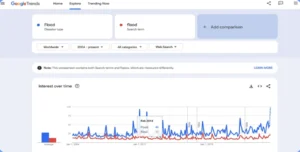
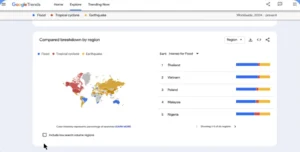
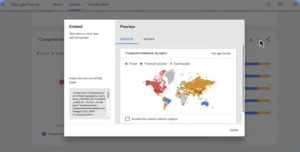
To start your analysis, search for this term on Google
Trends for the available time frame, starting in 2024. As you see in this graph, the topic storms do not seem to generate much interest. Let’s see what happens if we replace it with tropical cyclone, which is a type of storm that Includes the common term hurricane. Side note, notice that I’m using topics, Not Search terms. A topic is a group of search terms, which we also call an entity. It include the exact term searched as well as misspellings, variants, acronyms, And it covers all languages, which is useful when looking at global data. For example, if we look at flood as a topic and then as a search terms, you’ll notice how to topic has a higher search interest. That’s because it cover many search Related to the topic. Back to the comparison. And just for reference, the highest spike in search interest over the selected period related to the earthquakes in turkey February 2023. A close second was Hurricane Irma, a hurricane that caused widespread destruction across in path in September 2017. At this point, you might want to download the data into a CSV and combine it with others data sets. For example, you could match each spike in the line chart to the relevant natural Disaster and create an annotated chart with their details. In addition to the comparison of search interest over time, you can also find a comparison breakdown by region of the search interest for the disasters. This map shows you which topic highest search interest for each of the countries. Notice that you can check the box blow the map if you want to include low search volume region too. This map can be an impactful visual alongside and article. If you’re publishing the article online, you may imbed the map into page to offer and interactive version with live updates directly on your site. And finally, after the comparison by region, you’ll find for each individual topic a map showing interest by region and a table with related queries
Where you can check both the rising and the top queries in relation to each topic.
Hades has done a comparison between the way people search for nature disasters. We can how build on that to check if there is any difference search interest in each of your focus countries.
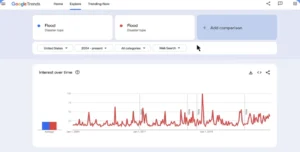

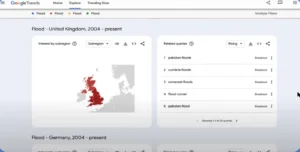
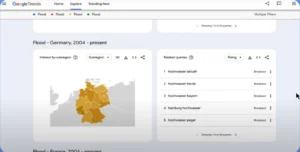
The first step is to create an advanced feature to show Trends over time for the each of the topics in each of the countries.
I’ll start with floods. Type in flood in the Google Trends Search Box and choose the topic flood disaster type. Choose United States and pick the date range starting in 2004. In the second search box type in flood and choose the same topic. Now hover over that search box and click the three dots menu. Select change Futures and the change the country to the United Kingdom. Repeat the same process for Germany and France. This chart shows the search interest in floods since 2004, where each line represents a different country. We can see in the bar chart that the UK has the highest search interest among the countries. You’ll notice that most spikes originate from the UK searches around the winter. This knowledge can help you plan your content ahead. Scrolling down for the each of the countries, you will see a map with search interest broken down by sub region, where darker shaded areas have a higher level of Search interest. You’ll also find the table with queries related to that specific topic. You can choose either the most popular ones or the ones with the biggest increase in search frequency to understand people’s behavior around this topic. You can repeat this process for tropical cyclones, where you’ll see that the United States has significantly more search interest that the others countries. The spike you see in the chart for September 2017 coincides with Hurricane Irma. Search interest was originated mostly from US searches. Finally if you repeat this process for earthquakes, you will see a significant spike in February 2023 as a result of the earthquakes in Turkey. Originated in Germany.
PLANNING YOUR CONTENT STRATEGY
As you can see, you can extract a lot of interesting data from this comparison. And there are so many compelling stories that can be distilled from an analysis like this. Now you have some idea about how to gather and analyze data for a story you’re covering. However, as a weather reporter, you will always encounter breaking stories. A well defined content strategy should combine planning ahead of special moments throughout the year while also allowing some bandwidth to monitor and report about breaking news. Let’s start with special moments. There are recurring events that people search for every year. You should have a calendar making the dates all you already know, like the change in seasons throughout the year.
For example, do you know what people search for?
Relation to spring?
Is it different for what people search for in relation to the summer? Maybe they’re interested in seasonal weather related topics. That’s something you should explore. So maybe leave some time a side to have content ready before people start Getting interested in the changing of the seasons. We discussed how to create a content calendar and the trends for SEO article. But while you can go a long way by planning ahead, you can’t play for breaking news. You just need to be on top of things. A good way to start is to take a quick look at what’s trending when you start your day. Navigate to Trending Now. In this pages you’ll see in terms are trending in past seven days, 24 hours, or even in the last hour. This is a great way for you to find breaking news and gather ideas for new articles. For example, during the recent eclipse, there was a lot of search interest for the term my eyes hurt.
This show how Google Trend can bring color to what’s going in the world by surfacing people’s immediate responses to news events. This is something you could have seen while preparing for your day, and maybe you could have written a short piece about it as it happened.
Once you find a search term that look like and interesting rising trend, you can investigate it further. Add the term to the explore page and choose the past 24 hours to monitor how the search interest is trending. Here are a few question you can answer using the data.

Is there a specific reasons where this tern is becoming popular?
Dose it correlate with an important piece of ongoing news?
Was there another peak in the history of this term or is this a completely new trend?
When you look at related queries, what are searchers asking in relation to it?
What sort of coverage is this topic getting?
Is there a gap in the coverage my publication might want to fill?
Put on your detective hat and off you go into the world off data.
TELLING STORIES WITH TRENDS DATA

Before we leave you to play around with the tool, I would like to highlight a few real life examples of data visualizations Created with Google Trends data. Those data stories might inspire your even more. We have also added links to the video description if you want to learn about more of them.
First example is searching for health. A tool that compares search interest for common health issues is the United States to the actual location of occurrences for those same health conditions. The visualization shows how search data reflects life for millions of Americans.
Second a sports, example, how the world is searching for the world Cup, which leverages Google Search interest to identify Trends throughout the 2022 world cup. It shows the most searched themes over the course of the tournament, players ranked by search interest, and the most searched national team in each country.
Last, the alternative Olympics medal table. This is a visualization showing what would happen if the Olympic medals were reranked based on other factors like population size, wealth, or search interest.
I am so glad we checked Google Trends and brought our ponchos to avoid getting drenched in the rain.
Having a finger on the pulse of breaking news can be very important to help people understand what’s happening around them. And what’s better, Google Trends can help not just us but journalists preparing data-driven news stories, and new companies creating their content Strategy.



